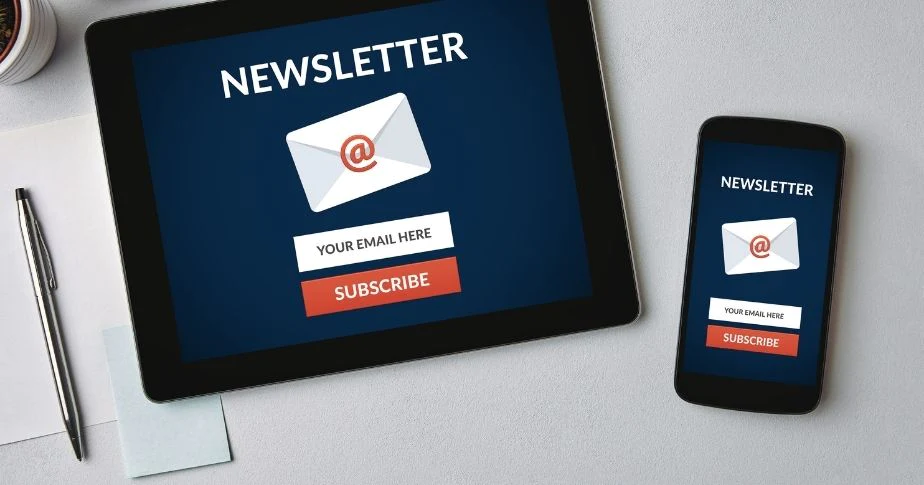
Best Practices for Email Marketing Consent: What You Need to Know
Securing email marketing consent is essential for compliance with laws and establishing trust with your subscribers. In this article, we’ll explore what email marketing consent entails, the types of consent, and the best ways to obtain it to optimize your marketing strategy.
Key Takeaways
-
Email marketing consent hinges on explicit and implied consent, each with distinct implications for legal compliance and audience engagement.
-
Adhering to regulations like GDPR, the CAN-SPAM Act, and CASL is essential to avoid legal penalties and maintain subscriber trust.
-
Implementing best practices for obtaining and managing consent, such as clear communication and double opt-in processes, fosters engagement and compliance.
Understanding Email Marketing Consent
Email marketing consent is more than just a legal checkbox; it’s a commitment to respect your audience’s preferences and choices. It signifies that your subscribers have willingly agreed to receive marketing communications, creating a foundation of trust and engagement. Without proper consent, your marketing efforts can backfire, leading to annoyed recipients and potential legal repercussions.
There are two primary types of email marketing consent: explicit and implied. Explicit consent is obtained when a user takes a clear and affirmative action to agree to receive marketing emails, such as checking a box on a sign-up form. Implied consent, on the other hand, is assumed based on a user’s actions, such as providing their email address during a purchase.
Recognizing these distinctions helps in developing effective and compliant email marketing strategies.
Explicit and Informed Consent
Explicit consent involves a clear, affirmative action by the user, such as checking a box on a sign-up form or clicking a confirmation link in an email. This method ensures that the subscriber is fully aware of their agreement, providing informed consent. For example, under Canada’s Anti-Spam Legislation (CASL), explicit consent can be obtained either orally or in writing, and it must be clear and unambiguous.
The double opt-in process is an excellent example of how explicit consent can be implemented effectively. This method requires subscribers to confirm their consent by clicking on a link sent to their email address, adding an extra layer of validation, which is a key aspect of confirmed opt in.
Although explicit consent may attract fewer subscribers, it guarantees a higher quality email list, resulting in better engagement and compliance with regulations like GDPR and CASL.
Implied Consent
Implied consent occurs when there is an assumption that the recipient would not mind receiving marketing emails based on their previous actions or relationships. For instance, a customer may provide their email address during a purchase or sign up for a service without explicitly agreeing to receive marketing messages. This type of consent is often easier to obtain but comes with its own set of challenges.
While implied consent can help marketers acquire a larger number of subscribers, it may lead to lower engagement and higher unsubscribe rates. Additionally, implied consent typically has time frame restrictions, such as being valid for only two years, and can pose deliverability issues if not managed carefully.
Seeking explicit consent from subscribers whenever possible can help mitigate these risks, requesting consent whenever appropriate.
Differences Between Explicit and Implied Consent
The primary difference between explicit and implied consent lies in the clarity and affirmative action taken by the subscriber. Explicit consent involves a clear agreement from the individual, often through a direct action like checking a box or confirming via email.
Implied consent, however, arises from existing relationships or inferred interactions, suggesting that the individual may be open to receiving communications without a formal agreement. While explicit consent ensures compliance with stricter regulations and fosters a more engaged audience, implicit consent is easier to obtain but can pose risks if not managed properly.
Legal Requirements for Email Marketing Consent

Navigating the legal landscape of email marketing can be daunting, but understanding the key regulations is essential for compliance and building trust with your audience. Various email marketing laws, such as the CAN-SPAM Act, GDPR, ePrivacy Directive, and CASL, aim to protect user privacy, prevent spam, and ensure ethical email marketing practices.
Non-compliance with these regulations can lead to hefty fines and damage to your reputation, necessitating a thorough understanding and adherence to these legal requirements.
General Data Protection Regulation (GDPR)
The General Data Protection Regulation (GDPR) is a cornerstone of data protection and privacy laws in the European Union. It mandates that businesses must obtain explicit consent from individuals before collecting and using their personal data for marketing purposes. GDPR emphasizes the importance of maintaining detailed consent records, including timestamps and the method of consent acquisition, to ensure compliance and mitigate legal risks.
Non-compliance with GDPR can result in severe penalties, including fines up to €20 million or 4% of global annual turnover, whichever is higher. This highlights the importance of adhering to GDPR requirements and implementing robust consent management practices to protect user data and maintain trust.
CAN-SPAM Act
The CAN-SPAM Act, enacted in 2003, sets the rules for commercial email messages in the United States and aims to protect recipients from unsolicited emails. Key requirements include providing a clear and conspicuous opt-out mechanism, honoring opt-out requests promptly, and ensuring that the header information is accurate and not misleading. Starting in 2024, bulk senders targeting Gmail and Yahoo are required to include a one-click unsubscribe feature, further emphasizing the importance of easy opt-out options.
Following the CAN-SPAM Act helps avoid legal repercussions and enhances your reputation as a responsible email marketer. Clear opt-out mechanisms and respect for subscribers’ choices build a more trusting and engaged audience.
ePrivacy Directive
The ePrivacy Directive, also known as the ePrivacy Regulation, governs electronic communications and works alongside GDPR to ensure the protection of personal data in the European Union. Under the ePrivacy Directive, marketers must obtain explicit consent from users before sending marketing communications, highlighting the need for clarity and transparency in consent requests.
For businesses operating in the EU, adhering to the ePrivacy Directive is essential as it complements GDPR and provides additional guidelines for electronic communications. Ensuring explicit consent and maintaining transparency fosters trust and compliance with both GDPR and the ePrivacy Directive.
Canada’s Anti-Spam Legislation (CASL)
Canada’s Anti-Spam Legislation (CASL) requires explicit consent before sending commercial electronic messages, which include emails, SMS, and instant messages. Consent can be either express, where permission is actively given, or implied, based on prior relationships or the public availability of an email address. Securing express consent requires clearly outlining the purposes for the request, along with the requester’s identity and contact details, including those from email service providers.
Every commercial electronic message sent under CASL must contain the sender’s name, the organization’s identity if different, and a method for recipients to unsubscribe easily. CASL applies to all entities that send messages for commercial purposes, making it essential for businesses to understand and comply with its requirements to avoid penalties and maintain a positive reputation.
Best Practices for Obtaining Consent
Effective consent procedures fulfill legal requirements, build customer trust, and enhance overall marketing strategies. Clear communication of the value proposition and understanding diverse preferences of prospects are key to developing a successful opt-in strategy. Companies often fail to provide clear opt-in mechanisms, leading to confusion about consent.
Incentives such as limited-time discounts, free resources, and exclusive offers can effectively encourage email subscriptions. By clearly communicating the benefits of subscribing, businesses can gather permission-based email subscriptions and foster a more engaged audience.
Using Sign Up Forms and Pop Ups
Building your mailing list with subscription forms and lead magnets is crucial for effective email marketing. Opt-in forms should feature concise messaging and eye-catching design to grab attention. Personalized content and integration with social media can further enhance these forms, driving greater engagement.
Consent forms should clearly state all purposes for data collection and provide links to privacy policies to ensure legal compliance. Checkboxes for separate agreements help obtain explicit consent for different types of communications, making the process transparent and user-friendly.
Double Opt-In Process
The double opt-in process requires subscribers to confirm their consent by clicking on a confirmation link sent to their email address, ensuring that only genuinely interested individuals are added to your mailing list. This method helps confirm the validity of email addresses, reducing bounce rates and improving deliverability.
Following the initial sign-up, a confirmation email is sent to the subscriber, who must verify their email to complete the subscription process. This step enhances the quality of your subscriber list and ensures compliance with regulations like GDPR and CASL.
Clear and Honest Communication
Transparency in email marketing helps recipients understand how their data will be used and builds trust between them and the sender. Clear and honest subject lines enhance trust and compliance, ultimately leading to better engagement and a positive brand image.
Managing and Maintaining Consent Records
Managing and maintaining consent records is essential for compliance with data protection laws like GDPR. Obtaining consent should involve transparent communication, checkboxes, explicit agreement, and confirmation emails to ensure accurate documentation and auditability.
Keeping Accurate Records
Maintaining evidence of consent is essential for compliance with laws such as the ePrivacy Directive. Accurate consent records should document who gave consent and when it was granted, including timestamps and the method used to obtain consent.
This information is crucial for establishing a clear timeline and demonstrating compliance during audits.
Regularly Updating Consent Lists
Regularly updating consent lists removes contacts who no longer wish to receive communications and corrects inaccuracies, reducing legal risks and ensuring compliance with evolving regulations for existing customers. Engaging in regular updates not only enhances customer trust but also alleviates potential legal repercussions.
Handling Unsubscribe Requests
Properly handling unsubscribe requests is crucial for maintaining a positive customer experience and avoiding spam reports. Companies often fail to provide a straightforward way for users to opt out of email communications, leading to frustration and damaging the sender’s reputation.
Providing Easy Unsubscribe Options
Including an unsubscribe link in both the header and footer of emails increases visibility and convenience for users. This approach ensures recipients can easily find and use the unsubscribe option, reducing frustration and maintaining a positive relationship with your audience. Opt-out links must be visually distinct and easily accessible, typically located in the email footer. Offering an email preference page allows users to adjust their subscription settings rather than completely opting out, providing a more flexible option for managing their email preferences.
Transparency in consent requests, including clear unsubscribe options, is crucial for fostering trust and compliance. Without it, subscribers may feel deceived, leading to higher unsubscribe rates and potential legal repercussions.
Processing Opt-Outs Efficiently
According to the CAN-SPAM Act, opt-out requests must be processed within ten business days. Promptly honoring unsubscribe requests is essential for maintaining compliance with privacy regulations like GDPR and for preserving customer trust.
Efficiently processing opt-outs helps avoid potential legal issues and ensures your email marketing practices remain respectful and compliant.
Common Pitfalls to Avoid
Respecting the recipient’s preferences and privacy is fundamental in email marketing. However, many companies make common mistakes that can undermine their efforts. Clarity in email marketing consent forms is essential; messages must be clear, truthful, and understandable to avoid confusion and ensure valid consent. Common errors include unclear disclosure, missing privacy policy links, and overly complex forms.
Transparency is another critical aspect. Failing to be transparent in consent requests can damage customer trust and result in legal repercussions. By maintaining transparency and clarity, businesses can foster trust and ensure compliance with regulations.
Ignoring Regional Laws
Adhering to regional email marketing laws is essential, as non-compliance can result in significant penalties. Overlooking these regulations, such as GDPR or CASL, can lead to hefty fines and loss of trust from your audience. For instance, potential fines for violating GDPR can be up to €20 million or 4% of global annual turnover, whichever is higher.
Implied consent may lead to compliance challenges due to varying jurisdictional regulations. Hence, understanding and complying with applicable laws in your business regions is crucial to avoid legal risks and maintain a positive reputation.
Overlooking Transparency
Clarity in email marketing consent disclosures ensures valid consent and helps recipients understand the consequences of their agreement. Lack of transparency can lead to invalid consent, damaging customer trust and resulting in legal repercussions.
By being transparent in consent requests, businesses can build trust and ensure compliance with privacy regulations.
Monitoring and Optimizing Consent Practices
Monitoring and optimizing consent practices is essential for maintaining compliance and enhancing engagement. Email engagement metrics help assess the effectiveness of consent practices, while tracking user behavior and feedback provides valuable insights for improvement.
Re-permission campaigns can refresh consent records and ensure compliance with evolving legal standards.
Analyzing Subscriber Engagement
Analyzing metrics such as click-through rates, open rates, and conversion rates is crucial for evaluating subscriber engagement. These metrics offer insights into how well your content resonates with subscribers, helping to identify the quality of your subscriber list and informing future strategies. Understanding unsubscribe feedback through optional surveys allows marketers to refine their engagement strategies and improve consent practices.
By analyzing subscriber engagement, businesses can enhance their email marketing campaigns, maintain a healthy subscriber list, and ensure compliance with consent regulations.
A/B Testing Consent Requests
A/B testing helps marketers refine their consent strategies by comparing different email variations to improve engagement. This method helps determine which version of a consent request is more effective in driving subscriber actions and can inform future strategies for optimizing consent requests and improving subscriber acquisition.
Summary
In summary, understanding and implementing best practices for email marketing consent is crucial for building trust, protecting user privacy, and ensuring compliance with various regulations. By obtaining explicit and informed consent, managing consent records, and handling unsubscribe requests efficiently, businesses can foster a more engaged and loyal subscriber base.
Implementing these practices not only fulfills legal requirements but also enhances your overall marketing strategy. By maintaining transparency and adhering to regional laws, businesses can create a positive brand image and build lasting relationships with their audience. Let’s commit to respectful and effective email marketing practices that benefit both businesses and subscribers.
Frequently Asked Questions
What is explicit consent in email marketing?
Explicit consent in email marketing refers to a clear and affirmative agreement from individuals, typically obtained through actions like checking a box or confirming via email, indicating their willingness to receive marketing communications. This ensures compliance and builds trust with your audience.
How does the double opt-in process work?
The double opt-in process ensures that only genuinely interested individuals are added to your mailing list by requiring subscribers to click a confirmation link in an email sent to them. This adds an extra layer of consent and security to your email communications.
What are the key requirements of the CAN-SPAM Act?
The key requirements of the CAN-SPAM Act include providing a clear opt-out mechanism, honoring opt-out requests promptly, and ensuring accurate header information. Additionally, starting in 2024, bulk senders will need to incorporate a one-click unsubscribe feature.
Why is maintaining accurate consent records important?
Maintaining accurate consent records is crucial for legal compliance with regulations like the GDPR and ePrivacy Directive. It ensures you have documented evidence of who granted consent, when it occurred, and how it was obtained, which is vital for audits and accountability.
What are the benefits of analyzing subscriber engagement?
Analyzing subscriber engagement offers valuable insights into the effectiveness of your content and the quality of your subscriber list. This information can guide improvements in your engagement strategies and consent practices.
Are you interested in finding out more? Browse the rest of our blog for other marketing tips. If you’re ready to create your first email, survey, sign-up form, or landing page then register for a free trial to get the tools you need to build powerful marketing campaigns!
© 2024, Vertical Response. All rights reserved.



